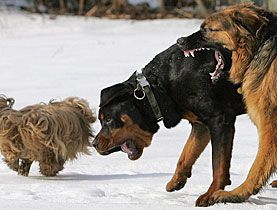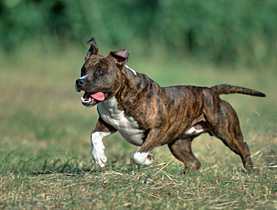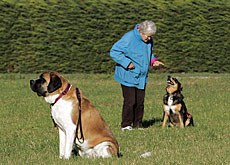Pitbulls named most dangerous dogs

American pitbull terriers, Rottweilers and Dobermanns are the most dangerous dogs in Switzerland, according to statistics for 2007 released on Thursday.
However, the head of the Federal Veterinary Office wondered whether the problem and burden of responsibility did not lie more with dog owners.
Last year 4,291 dog attacks were reported, of which 2,678 were on humans. There were also 309 cases of dogs being reported for nuisance behaviour.
In more than 1,000 cases cantonal vets ordered measures, such as muzzles, to be taken to improve safety.
Dog breeds were recorded for the first time last year when attacks were reported, and although most attacks were committed by the most popular breeds, certain trends were visible.
There was roughly one attack reported per 100 dogs, but certain breeds were above this one per cent national average: 8.5 per cent of American pitbull terriers bit a human or another dog, and 3.8 per cent of Rottweilers, 2.6 per cent of Dobermanns and two per cent of German Shepherds were involved in attacks.
Pitbulls however bite other dogs significantly more than they bite humans, according to the report.
Owner’s responsibility
But Hans Wyss, head of the veterinary office, said these figures did not prove pitbulls as a breed were more dangerous than other so-called “fighting dogs”.
“It’s totally possible that a pitbull in the hands of a competent owner poses no increased risk,” he said, welcoming the fact that from September 1 every owner of a new dog has to complete a dog-training course, irrespective of the breed.
“We’ll have to keep an eye on whether these measures are enough for the more challenging breeds,” he admitted.
Thursday’s results also showed that children were bitten more often than adults and suffered more serious wounds, with injuries to the head or throat seen in half of incidents involving children under ten. Adults more often suffer injuries to the hands, arms and legs.
However, a quarter of attacks on children were committed by small dogs, which for the veterinary office highlighted the need for “owners of small dogs to be able to control them”.
Tighter leash
The emotional and increasingly political debate surrounding dangerous dogs in Switzerland was sparked by a fatal attack by three pitbull terriers on a six-year-old boy in 2005.
Most voters and tabloid editors take a dim view of dogs such as pitbulls and Rottweilers, whereas most vets say drawing up lists of so-called dangerous dogs is pointless as all dogs are potentially dangerous.
In February voters in canton Geneva agreed to tighten the leash, banning 12 breeds of dogs considered dangerous and requiring owners whose dogs weigh more than 25kg to have a permit to walk them in public.
Although Geneva is a canton of dog lovers – 32,000 dogs live on its territory of less than 250 square kilometres – two-thirds of voters supported stricter rules. These followed tighter controls on the ownership of dogs passed in June 2007.
The existing law already required all dog owners to follow a complete obedience course with their animal and people who walk dogs for other people to hold a licence.
Owners of dangerous dogs must also hold a licence, prove they have completed a dog-training course and that the animal comes from an approved breeder. It is illegal to breed or cross fighting dogs, and just one dog of a dangerous breed is allowed per household. Dangerous dogs also have to wear a muzzle in public spaces.
Lax internationally
Bans on dangerous dogs had already been imposed in cantons Valais and Fribourg and are under discussion in several other cantons. So far there have been no specific nationwide laws on the issue.
Indeed compared with France, Italy, Germany and Britain, Swiss legislation on dangerous dogs is considered among the least restrictive in Europe.
At the federal level, following the 2005 fatal pitbull attack, parliament debated measures to protect the population and called on the government to strengthen federal legislation.
A parliamentary commission was set up and is currently discussing a draft law on dangerous dogs.
swissinfo with agencies
Each year, around 13,000 people in Switzerland are bitten by a dog and need medical treatment.
A Swiss Federal Veterinary Office report looking into dog bites in 2002 found that 24% of victims were bitten by their own dog, 34% by a dog they knew and 42% by a dog unknown to them.
A fatal attack by three pitbull terriers on a six-year-old boy in 2005 sparked renewed debate about a law on dangerous dogs.
Parliament debated measures to protect the population against dangerous dogs. The Senate and the House of Representatives supported a motion calling for legislation at federal level.
Under current Swiss legislation each of the country’s 26 cantons is responsible for setting laws to control dog ownership.
The law on the protection of animals made it compulsory from January 1, 2007 for all dogs to have a tattoo or microchip.
Since May 2006 dog bites and dogs behaving aggressively have had to be reported to the cantonal authorities.
Dog owners currently are not responsible for damage if they can prove that their pets have been kept correctly. Under a draft law, to be discussed by parliament at a later stage, dog owners would also have to take out mandatory insurance.

In compliance with the JTI standards
More: SWI swissinfo.ch certified by the Journalism Trust Initiative



You can find an overview of ongoing debates with our journalists here. Please join us!
If you want to start a conversation about a topic raised in this article or want to report factual errors, email us at english@swissinfo.ch.